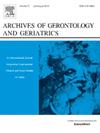Successful aging rates of global older adults: A subgroup meta-analysis
IF 3.8
3区 医学
Q2 GERIATRICS & GERONTOLOGY
引用次数: 0
Abstract
Objective
The aim of this study was to assess the successful aging (SA) rates of individuals aged 60 and above in different subgroups based on gender, age, region, etc., in order to provide a scientific basis for improving the quality of life of the older adults.
Setting and Participants
Older adults (≥60 years).
Methods
A systematic review was conducted by searching six electronic databases including PubMed, Embase, CINAHL, Web of Science, SCOPUS, and PsycINFO as of July 17, 2023. Quality assessment, screening, data extraction, and analysis were performed following the Preferred Reporting Items for Systematic Reviews and Meta-Analyses (PRISMA) and the Meta-analysis Of Observational Studies in Epidemiology (MOOSE) guidelines. A total of 64 studies involving 546 228 individuals aged 60 and above were included, and subgroup analyses were conducted based on sex, age, region, study time, and study quality. Statistical analyses were conducted using Revman 5.3 and Stata 11.0.
Results
The SA rate was higher in males (26.0 %, 95 % CI 22.0 %-30.0 %) compared to females (19.0 %, 95 % CI 16.0 %-22.0 %). The SA rates in older adults in the 60–69 (36.0 %), 70–79 (30.0 %), and 80+ (19.0 %) age groups showed a decreasing trend. In regional subgroup analysis, SA rates were higher in North America (30.0 %) and South America (26.0 %), and lower in Asia (19.0 %), Africa (17.0 %), Oceania (16.0 %) and Europe (15.0 %). The SA rate before 2010 (26.0 %) was higher than that 2010 and after (22.0 %). Compared to low quality studies (18.0 %), high quality studies (27.0 %) had a higher SA rate.
Conclusions and Implications
The study found that males had a higher SA rate than females, and the SA rate decreased with age. There were regional differences in SA rates. Variations in economic and educational levels among different countries may affect the likelihood of achieving SA in the older population. Measures are recommended to improve the living conditions of older adults with low education and economic status.
全球老年人成功老龄化率:亚组荟萃分析
目的探讨基于性别、年龄、地区等不同亚组的60岁及以上老年人成功老龄率,为提高老年人生活质量提供科学依据。研究对象:年龄≥60岁的成人。方法通过检索截至2023年7月17日的PubMed、Embase、CINAHL、Web of Science、SCOPUS、PsycINFO等6个电子数据库进行系统评价。质量评估、筛选、数据提取和分析按照系统评价和荟萃分析首选报告项目(PRISMA)和流行病学观察性研究荟萃分析(MOOSE)指南进行。共纳入64项研究,涉及546 228名60岁及以上的个体,并根据性别、年龄、地区、研究时间和研究质量进行亚组分析。采用Revman 5.3和Stata 11.0进行统计学分析。结果男性的SA发生率(26.0%,95% CI 22.0% ~ 30.0%)高于女性(19.0%,95% CI 16.0% ~ 22.0%)。60-69岁、70-79岁和80+年龄组的SA发生率呈下降趋势,分别为36.0%、30.0%和19.0%。在区域亚组分析中,SA率在北美(30.0%)和南美(26.0%)较高,而在亚洲(19.0%)、非洲(17.0%)、大洋洲(16.0%)和欧洲(15.0%)较低。2010年之前的SA率(26.0%)高于2010年之后的SA率(22.0%)。与低质量研究(18.0%)相比,高质量研究(27.0%)的SA率更高。结论与意义研究发现男性SA发生率高于女性,且SA发生率随年龄增长而降低。SA发生率存在地区差异。不同国家之间经济和教育水平的差异可能会影响老年人实现SA的可能性。建议采取措施改善受教育程度和经济状况较低的老年人的生活条件。
本文章由计算机程序翻译,如有差异,请以英文原文为准。
求助全文
约1分钟内获得全文
求助全文
来源期刊
CiteScore
7.30
自引率
5.00%
发文量
198
审稿时长
16 days
期刊介绍:
Archives of Gerontology and Geriatrics provides a medium for the publication of papers from the fields of experimental gerontology and clinical and social geriatrics. The principal aim of the journal is to facilitate the exchange of information between specialists in these three fields of gerontological research. Experimental papers dealing with the basic mechanisms of aging at molecular, cellular, tissue or organ levels will be published.
Clinical papers will be accepted if they provide sufficiently new information or are of fundamental importance for the knowledge of human aging. Purely descriptive clinical papers will be accepted only if the results permit further interpretation. Papers dealing with anti-aging pharmacological preparations in humans are welcome. Papers on the social aspects of geriatrics will be accepted if they are of general interest regarding the epidemiology of aging and the efficiency and working methods of the social organizations for the health care of the elderly.

 求助内容:
求助内容: 应助结果提醒方式:
应助结果提醒方式:


